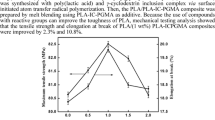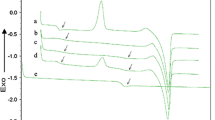Abstract
A series of cross-linked glycidyl azide polymer with poly(ethylene oxide-co-tetrahydrofuran) (GAP/P(EO-co-THF)) blends were prepared by varying the relative weight ratios of GAP to P(EO-co-THF) using poly-isocyanate mixed curing system (N100/TDI), and by varying the [NCO]/[OH] ratios to find the effects of curing agents on mechanical properties. The compatibility, thermal features and morphological studies of GAP/P(EO-co-THF) polymer networks were described by equilibrium phase diagram, differential scanning calorimeters (DSC) together with thermogravimetric analysis (TGA), scanning electron microscopy (SEM), respectively. The equilibrium phase figure of the partial miscibility system for GAP/P(EO-co-THF) shows that the system has a lower critical solution temperature (LCST). In addition, the DSC and TGA results indicate that the content of two components is gradually approaching, and the glass transition temperatures of GAP/P(EO-co-THF) blends are less than those of the pure GAP and P(EO-co-THF) polymers, and the initial decomposition temperature and the maximum decomposition rate temperature have greatly increased. Furthermore, the thermal decomposition behavior indicates that the thermal stabilities are improved and the physical entangled networks are strengthened. Moreover, the scanning electron microscopy (SEM) images show the GAP/P(EO-co-THF) blends form a certain polymer alloy structure, which is the reason for the improved thermal stabilities and the strengthened networks.









Similar content being viewed by others
References
Kanti Sikder A, Reddy S (2013) Review on energetic thermoplastic elastomers (ETPEs) for military science. Propellants Explos Pyrotech 38(1):14–28
Badgujar DM, Talawar MB, Asthana SN (2008) Advances in science and technology of modern energetic materials: an overview. J Hazard Mater 151(2):289–305
Consaga JP, French DM (1971) Properties of hydroxyl-terminated polybutadiene-urethane systems. J Appl Polym Sci 15(12):2941–2956
Hovetborn T, Holscher M, Keul H, Höcker H (2006) Poly (ethylene oxide-co-tetrahydrofuran) and Poly (propylene oxide-co-tetrahydrofuran): synthesis and thermal degradation. Rev Roum Chim 51(7/8):781
Nazare A, Asthana S, Singh H (1992) Glycidyl azide polymer (GAP)-an energetic component of advanced solid rocket propellants-a review. J Energ Mater 10(1):43–63
Frankel M, Grant L, Flanagan J (1992) Historical development of glycidyl azide polymer. J Propul Power 8(3):560–563
Beckstead MW, Puduppakkam KV, Thakre P, Yang V (2007) Modeling of combustion and ignition of solid-propellant ingredients. Prog Energy Combust Sci 33(6):497–551
Manu SK, Varghese TL, Mathew S (2009) Studies on structure property correlation of cross-linked glycidyl azide polymer. J Appl Polym Sci 114(6):3360–3368
Cerri S, Bohn MA, Menke K (2014) Characterization of ADN/GAP-Based and ADN/desmophen-based propellant formulations and comparison with AP analogues. Propellants Explos Pyrotech 39(2):192–204
Sekkar V, Bhagawan SS, Prabhakaran N (2000) Polyurethanes based on hydroxyl terminated polybutadiene: modelling of network parameters and correlation with mechanical properties. Polymer 41(18):6773–6786
Selim K, Özkar S, Yilmaz L (2000) Thermal characterization of glycidyl azide polymer (GAP) and GAP-based binders for composite propellants. J Appl Polym Sci 77(3):538–546
Gaur B, Lochab B, Choudhary V (2003) Azido polymers-energetic binders for solid rocket propellants. J Macromol Sci Part C Polym Rev 43(4):505–545
Stacer RG, Husband DM (1991) Molecular structure of the ideal solid propellant binder. Propellants Explos Pyrotech 16(4):167–176
Mohan YM, Raju MP, Raju KM (2005) Synthesis and characterization of GAP-PEG copolymers. Int J Polym Mater 54(7):651–666
Menke K, Heintz T, Schweikert W (2009) Formulation and properties of ADN/GAP propellants. Propellants Explos Pyrotech 34(3):218–230
Min BS (2008) Characterization of the plasticized GAP/PEG and GAP/PCL block copolyurethane binder matrices and its propellants. Propellants Explos Pyrotech 33(2):131–138
Davenas A (2003) Development of modern solid propellants. J Propul Power 19(6):1108–1128
Min BS, Ko SW (2007) Characterization of segmented block copolyurethane network based on glycidyl azide polymer and polycaprolactone. Macromol Res 15(3):225–233
Min BS, Baek G, Ko SW (2007) Characterization of polyether-type GAP and PEG blend matrices prepared with varying ratios of different curatives. J Ind Eng Chem 13(3):373–379
Landsem E, Jensen TL, Hansen FK et al (2012) Neutral polymeric bonding agents (NPBA) and their use in smokeless composite rocket propellants based on HMX-GAP-BuNENA. Propellants Explos Pyrotech 37(5):581–591
Manu SK, Varghese TL, Joseph MA et al (2004) Physical, mechanical and morphological characteristics of chain modified GAP and GAP-HTPB binder matrices. In: International Annual Conference-fracunhofer Institut fur Chemische Technologie
Mohan YM, Raju KM (2005) Synthesis and characterization of HTPB-GAP cross-linked co-polymers. Des Monomers Polym 8(2):159–175
Panda SP, Sahu SK, Sadafule DS et al (2000) Role of curing agents on decomposition and explosion of glycidyl azide polymers. J Propul Power 16(4):723–725
Bui VT, Ahad E, Rheaume D et al (1996) Energetic polyurethanes from branched glycidyl azide polymer and copolymer. J Appl Polym Sci 62(1):27–32
Mathew S, SeK Manu, TeL Varghese (2008) Thermomechanical and morphological characteristics of cross-linked GAP and GAP–HTPB networks with different diisocyanates. Propellants Explos Pyrotech 33(2):146–152
Herder G, Weterings F, de Klerk W (2003) Mechanical analysis on rocket propellants. J Therm Anal Calorim 72(3):921–929
Krabbendam-La Haye E, de Klerk W, Miszczak M et al (2003) Compatibility testing of energetic materials at TNO-PML and MIAT. J Therm Anal Calorim 72(3):931–942
Author information
Authors and Affiliations
Corresponding author
Rights and permissions
About this article
Cite this article
Li, Y., Li, J., Ma, S. et al. Compatibility, mechanical and thermal properties of GAP/P(EO-co-THF) blends obtained upon a urethane-curing reaction. Polym. Bull. 74, 4607–4618 (2017). https://doi.org/10.1007/s00289-017-1978-2
Received:
Revised:
Accepted:
Published:
Issue Date:
DOI: https://doi.org/10.1007/s00289-017-1978-2




